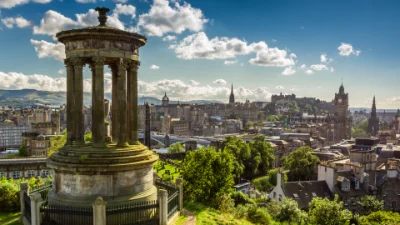Scotland
Embark on an unforgettable adventure as you travel to Scotland, where the land tells timeless tales through its enchanting landscapes and historical treasures. Imagine walking the rugged paths of the Scottish Highlands, enveloped by the crisp, invigorating air that carries the faint aroma of heather and wild thyme. As you travel through Scotland, let the haunting melody of bagpipes serenade you amidst ancient standing stones that whisper secrets of a long-forgotten era. Marvel at the majesty of Edinburgh Castle perched atop a volcanic rock, overlooking the city with storied grandeur. At every turn, lochs mirror the dramatic skies above, inviting moments of reflection and awe. Delight in the rich flavors of award-winning Scotch whisky that warmly tingles the senses while savoring traditional haggis, a dish that embodies the country's unique culinary heritage. Scotland invites you to journey deeper into its heart, where every corner offers a story waiting to be discovered—a place where myths and history dance together in an unforgettable symphony of experiences.
Scotland Travel Season
Scotland is a captivating destination that offers unique experiences throughout the year. Traveling to Scotland can be most delightful during the peak season, which falls between late spring and early autumn, specifically from June to August. During these months, the weather is generally milder, and the days are long, allowing plenty of time for exploration. Expect Scotland's landscapes to burst with lush greenery, and iconic sights like the Highlands, Isle of Skye, and Edinburgh are easily accessible. However, this season also attracts the largest number of tourists, which can lead to crowded attractions and higher prices for accommodations and flights.
For those looking to travel to Scotland when the weather is favorable but seeking fewer crowds, late spring and early autumn are ideal. Months like May and September offer a more tranquil experience, as the bulk of summer tourists have yet to arrive or have just departed. The weather can still be comfortably mild, perfect for taking scenic hikes or exploring the vibrant cities without the hustle and bustle. During this time, travelers might discover better deals on hotels and have a greater opportunity to interact with locals, providing a richer cultural experience.
As autumn progresses into October and November, Scotland transforms into a haven of colorful foliage. These months are excellent for travelers who want to savor the beauty of Scotland in peaceful solitude. While the temperatures can start to drop, the landscapes remain stunningly vibrant, making it perfect for photography enthusiasts. Many of the tourist attractions are still open, but with significantly fewer visitors, allowing for a more intimate experience of Scotland's history and heritage.
Though winter might seem less inviting due to colder weather, traveling to Scotland between December and February can offer magical experiences. The festive season sees cities like Edinburgh and Glasgow come alive with Christmas markets, light festivals, and Hogmanay celebrations—a unique Scottish New Year celebration that is world-renowned for its vibrant street parties and firework displays. Additionally, for those interested in winter sports, resorts in the Cairngorms offer skiing and snowboarding opportunities against breathtaking icy backdrops.
Spring in Scotland is characterized by blooming flowers and emerging wildlife, setting the stage for excellent nature walks and visits to Scotland's beautiful gardens such as the Royal Botanic Garden in Edinburgh. Travelers during March and April can expect fewer crowds than summer, aside from Easter holidays when local tourism may spike. This season is particularly rewarding for those who enjoy birdwatching and discovering the myriad of species that migrate or reappear as the weather warms.
Traveling to Scotland during the off-peak season holds its own perks. Not only can visitors benefit from more affordable accommodations and leisurely exploration, but they also gain the chance to participate in unique, lesser-known events. Whether it's witnessing the traditional Gaelic festivals or exploring hidden architectural gems without the distraction of crowded spaces, travel to Scotland outside the high season offers an enriching sense of authenticity.
The Weather and Seasons in Scotland
Traveling to Scotland offers a unique experience with its diverse climate and stunning landscapes. Situated in the northern part of the British Isles, Scotland's weather can vary significantly throughout the year. While planning your travel to Scotland, it is important to consider the different seasons and how they might affect your itinerary.
Spring in Scotland
Spring in Scotland begins in March and extends through May. During this time, temperatures start to rise after the cold winter months, averaging between 45°F (7°C) and 55°F (13°C). Travelers can expect an increase in daylight hours, providing more time to explore the scenic countryside. Rainfall is relatively moderate during spring, but it is wise to bring waterproof clothing, as rain showers are still common. This season is an ideal time for travel to Scotland, with blooming flowers and green landscapes offering picturesque views.
Summer in Scotland
Summer, lasting from June to August, is the warmest period in Scotland, with temperatures ranging from 55°F (13°C) to 70°F (21°C). This is the peak travel season, as the weather is generally pleasant and days are long. Visitors may experience occasional rain, but it is less frequent compared to other seasons. The summer months are perfect for exploring Scotland’s outdoor attractions such as the Highlands, islands, and lochs. Many local festivals and events occur during summer, providing cultural insights alongside natural beauty.
Autumn in Scotland
Autumn in Scotland is from September to November. During this season, temperatures drop gradually, ranging from 50°F (10°C) in early autumn to around 40°F (4°C) by November. The weather becomes more unpredictable, with increased chances of rain and wind. Despite this, autumn is a visually spectacular time to visit Scotland, as the foliage turns vibrant shades of orange and gold. When planning travel to Scotland during autumn, include indoor activities and prepare for variable weather conditions.
Winter in Scotland
Winter extends from December to February, and is characterized by cold and often harsh weather. Temperatures can plunge to 30°F (-1°C) and even lower in the Highlands. Snowfall is common in the northern regions, making it a fantastic time for winter sports enthusiasts. However, visitors should be prepared for shorter days and more persistent rain or snow in southern areas. This season is less crowded, providing those who travel to Scotland with a more tranquil and intimate experience.
While planning travel to Scotland, travelers need to be prepared for varied weather conditions, whichever season they choose to visit. Each season offers its own charm and set of activities, whether that includes experiencing local festivals during summer, embracing the lush landscapes during spring, marveling at autumnal colors, or basking in the serenity of a winter wonderland. Keep in mind that Scotland’s weather is famously unpredictable, making layers and waterproof clothing essentials for any travel itinerary. Whether you're exploring ancient castles, traversing rolling hills, or indulging in Scottish culture, the climate forms a quintessential part of the Scottish travel experience.
Accepted Payment Methods and Other Payment Information in Scotland
Travel to Scotland offers a blend of historical allure and stunning landscapes and when planning a trip, it's essential to understand the various payment options available. Scotland, as part of the United Kingdom, uses the local currency, which is the British Pound Sterling (£). Visitors will find banknotes issued by various Scottish banks, which are widely accepted and are equivalent in value to those issued by the Bank of England. When considering travel to Scotland, it's important to note that cash is still a commonly used means of payment, particularly in smaller towns and rural areas.
Credit Card Usage in Scotland
Credit card usage is widespread throughout Scotland, making it convenient for travelers. Most businesses, ranging from restaurants to hotels and retail stores, accept major credit cards. Visa and Mastercard are the most commonly accepted, presenting minimal to no issues for travelers carrying these cards. American Express is also widely accepted, though not as universally as Visa and Mastercard, so it’s advisable to carry a backup card if American Express is your primary card. Discover cards, however, are less frequently accepted, so travelers with these cards should have an alternative payment method available during their visit to Scotland.
Limitations on Certain Card Types
While Visa and Mastercard are the go-to options for travel to Scotland, some limitations may arise with other card types. American Express users might find certain establishments, especially in rural or smaller businesses, that do not accept this card due to higher transaction fees charged to merchants. Discover cardholders, in particular, will face more challenges, as the Discover network isn’t as extensive in Europe, including Scotland. To ensure a smooth travel experience in Scotland, it’s prudent to have a backup payment method, whether it be another credit card or cash.
Cash Usage
Despite the convenience of cards, cash remains an essential part of travel in Scotland. Smaller shops, local markets, and some family-run bed and breakfast establishments might only accept cash. ATMs are widely available, and it's advisable to withdraw some cash upon arrival for situations where cards aren’t accepted. Understanding when to use cash over card can enhance a traveler's experience in Scotland, especially when engaging with local businesses.
Tipping Etiquette
Tipping in Scotland follows a sensible guideline, and understanding this can ensure a more culturally aware travel experience. In restaurants, it is customary to leave a tip of about 10-15% if the service has been satisfactory. Some restaurants include a service charge on the bill, in which case no additional tip is necessary. Tipping in bars is not obligatory, though rounding up the bill or leaving small change is appreciated. When staying in Scottish hotels, a small tip for good service, such as for porters or housekeeping, is considered polite. Taxi drivers also appreciate tips, usually given by rounding up to the nearest pound.
Other Payment Considerations
For those journeying to Scotland, using contactless payments has become increasingly common, offering a quick and efficient alternative to cash and card swipes. Most vendors have adopted this technology, allowing travelers to simply tap and pay. Adopting this approach can significantly streamline transactions, especially in busy urban areas or during peak tourist seasons. Always ensure your card or mobile payment method is enabled for international use to take advantage of this convenience when you travel to Scotland.
Why You Should Travel to Scotland
Travel enthusiasts should consider Scotland for its rich tapestry of history, culture, and natural wonders. Whether you're a history buff, a nature lover, or simply in search of a unique travel experience, Scotland offers an abundance of reasons to explore its enchanting landscapes and vibrant cities. From ancient castles to stunning highlands, each corner of Scotland unveils a new discovery.
Majestic Castles and Historic Monuments
Travel to Scotland to explore its majestic castles, where history comes alive through imposing structures and ancient ruins. Iconic sites such as Edinburgh Castle, Stirling Castle, and the eerie beauty of Dunnottar Castle provide a glimpse into Scotland's tumultuous past. The country's rich history is preserved in these stone fortresses, inviting visitors to step back in time and imagine life in the eras of kings and queens.
Breathtaking Natural Landscapes
Scotland is a paradise for nature lovers, offering breathtaking landscapes that range from the rugged Highlands to the serene lochs and sweeping glens. The Isle of Skye, with its dramatic cliffs and otherworldly landscapes, is a must-see for any traveler. The Cairngorms National Park and Loch Lomond & The Trossachs National Park offer countless opportunities for hiking, wildlife watching, and soaking in the natural beauty.
Vibrant Cultural Festivals
Throughout the year, Scotland hosts a variety of vibrant cultural festivals that celebrate its rich heritage and contemporary creativity. The world-famous Edinburgh Festival Fringe is the largest arts festival in the world, drawing performers and audiences from all corners of the globe. Meanwhile, traditional Scottish events such as the Royal Edinburgh Military Tattoo and Highland Games showcase Scotland's fascinating customs and spirited cultural identity.
Whisky Distilleries and Culinary Delights
Travel to Scotland for the opportunity to indulge in its renowned whisky distilleries. The country is home to the Whisky Trail, a captivating route through some of the finest distilleries in the world. Pair your whisky tasting with Scotland's evolving culinary scene, which boasts everything from traditional dishes like haggis to innovative fine dining experiences that highlight local produce.
Rich Mythology and Folklore
Scotland's rich mythology and folklore add a mystical dimension to its already captivating landscape. Tales of mythical creatures like the Loch Ness Monster and Celtic legends are woven into the fabric of Scottish culture. Visiting places like the mysterious Standing Stones of Callanish or the Fairy Pools on the Isle of Skye allows visitors to feel the allure of these ancient stories.
Engaging Historical Sites and Museums
History buffs traveling to Scotland will find an abundance of engaging historical sites and museums. From the immersive experience at the Culloden Battlefield to the detailed exhibits at the National Museum of Scotland, these sites provide invaluable insights into the country's complex history and cultural evolution.
Charming Towns and Villages
Beyond the major cities, Scotland is dotted with charming towns and villages that offer a glimpse into local life. Places like St Andrews, with its world-renowned university and golf courses, and the fishing villages of Fife provide a serene setting filled with character and tradition. Each of these locales offers unique Scottish experiences, from cozy pubs to artisan shops.
Friendly Locals and Warm Hospitality
Travel to Scotland and you'll be met with the warmth of its people. Known for their friendliness and hospitality, Scots are always eager to share their culture and stories with visitors. Whether you're receiving recommendations for local attractions or simply having a chat in a pub, the locals' genuine kindness will make your visit memorable.
Unique Wildlife and Natural Reserves
Scotland's diverse ecosystems and natural reserves are home to unique wildlife, making it an ideal destination for wildlife enthusiasts. Travel to Scotland to witness its rich biodiversity, from the famous Highland cows and red deer to the elusive golden eagles and Scottish wildcats. The country’s marine life is equally fascinating, with opportunities to spot dolphins, seals, and even whales along the coasts.
Picturesque Rail Journeys
Another compelling reason to travel to Scotland is the opportunity to experience picturesque rail journeys. Trains like the West Highland Line and the Jacobite Steam Train offer breathtaking views of the Scottish countryside, allowing you to sit back and enjoy the scenery. These routes are not only efficient modes of transportation but also iconic experiences, famously used in films like "Harry Potter" for their scenic beauty.
The History of Scotland
Scotland is a treasure trove of history, where past and present seamlessly intertwine, offering an enchanting experience for those who travel to explore its rich heritage. Situated in the northern part of Great Britain, Scotland has been inhabited for thousands of years, with its history intricately linked to its breathtaking landscapes. Ancient sites such as the Neolithic village of Skara Brae and the standing stones of Callanish bear witness to the region's early settlers, who began shaping its cultural landscape as far back as 3200 BC. Historians and travel enthusiasts alike find these landmarks an exhilarating escape into the distant past.
The storied past of Scotland is replete with tales of battles, kings, and clans, each leaving an indelible mark on its unique identity. The Romans ventured into Scotland during their British conquest, yet it was during the Middle Ages that Scotland truly began to crystallize its identity with the emergence of the clans and the construction of its formidable castles. Edinburgh Castle and Stirling Castle are iconic reminders of the turbulent times and are essential stops for anyone traveling to Scotland. These fortresses not only offer insights into formidable historical events like the Wars of Scottish Independence but also provide panoramic views that spectacle visitors with their scenic surroundings.
A travel itinerary in Scotland would be incomplete without delving into its cultural heritage, deeply influenced by its Celtic roots and Norse heritages. The city of Edinburgh, renowned for its annual Edinburgh Festival, has become a modern beacon of culture and arts, drawing travelers from around the world to experience its vibrant atmosphere. Equally captivating are events such as the Highland Games, which showcase traditional Scottish sports, music, and dance. These events provide lively displays of Scottish culture, offering travelers an immersive experience and understanding of the customs and traditions that have endured through the centuries.
Scotland's natural beauty is as compelling as its historical and cultural narratives, with the Highlands and Isles offering some of the most picturesque landscapes in the world. Loch Ness and the mythical tales of its monster, the lush greenery of Glencoe, and the dramatic cliffs of the Isle of Skye grant a tranquil respite from the clamor of city life and invite contemplation. For those who travel to Scotland, these landscapes serve as a reminder of the untouched beauty that has inspired poets, writers, and travelers for generations. Embarking on a journey through Scotland is not just a lesson in history but a comprehensive immersion in an enduring legacy that continues to captivate and allure visitors from all corners of the globe.
The Culture of Scotland
Scotland is a land rich in history, tradition, and cultural vitality, making it a fascinating destination for travelers seeking to experience a unique blend of past and present. The Western European nation is renowned for its distinctive customs and vibrant traditions which are deeply rooted in its storied past. Known for its iconic Highland Games, Scotland showcases a series of events that celebrate Scottish and Celtic culture through athletic competitions, music, and dance. These games, typically held in the warmer months, attract visitors from around the world, eager to see the caber toss and other traditional Scottish sports. Traveling to Scotland during these events offers a fantastic opportunity to witness the nation’s cultural heritage in action.
The bustling cities and serene landscapes of Scotland come alive during its numerous festivals. One of the most celebrated festivals is the Edinburgh Festival Fringe, the largest arts festival in the world, where performers take to the streets and venues are filled with an endless variety of performances. Hogmanay is Scotland's famous New Year celebration, marked by street parties, traditional music, and fireworks, providing an exhilarating way to ring in a new year. Scottish cultural expressions through music and dance are also prominent, with the sound of bagpipes being an immediately recognizable symbol of Scottish heritage. Visitors who travel to Scotland can immerse themselves in ceilidh dancing, an upbeat and engaging form of folk dance that often accompanies social gatherings.
Daily customs in Scotland are a mix of modern and traditional influences, demonstrating the country's ability to embrace new cultures while maintaining its own identity. Scots are known for their warm hospitality and friendliness, always ready to share tales of their homeland over a dram of whisky, another symbol deeply woven into the cultural fabric. Food plays a significant role in the culture, with Scottish cuisine offering hearty dishes like haggis, neeps and tatties, and fresh seafood straight from its coastal waters. Travelers seeking an authentic experience will find that exploring local markets and dining in traditional Scottish inns offer great insight into the daily life of the locals.
Scotland's multicultural population contributes to its dynamic culture, where influences from various international communities enrich the local traditions and widen the cultural tapestry. This diversity is reflected in the variety of cuisines, languages, and art forms available. Furthermore, Scotland has a proud Celtic heritage with efforts actively made to preserve this part of its identity. There are initiatives aimed at keeping the Gaelic language alive and promoting Scottish Gaelic music and literature. These cultural preservation efforts are evident in festivals like the Royal National Mòd, which celebrates Gaelic culture through competitions in music, language, and art. For those planning to travel to Scotland, engaging with these cultural experiences promises to deliver an enriching and memorable journey through a land where tradition and innovation intertwine seamlessly.
The Culinary Experience of Scotland
Travel to Scotland promises a culinary journey as rich and varied as its stunning landscapes. From the bustling urban centers of Glasgow and Edinburgh to the serene lochs and highlands, Scotland's food scene offers a delectable mix of traditional and modern cuisine. Central to Scottish cuisine are locally sourced ingredients, providing fresh and flavorful dishes that showcase the country's rich resources. The use of indigenous produce such as Angus beef, Scottish salmon, venison, and a wide range of seafood from the surrounding North Atlantic waters ensures that every meal is a testament to Scotland's bountiful larder.
When you travel to Scotland, you must not miss trying iconic dishes like Haggis, Neeps and Tatties, and the classic Scottish Breakfast. Haggis, a savory meat pudding, is the national dish and is traditionally served with Neeps (turnips) and Tatties (mashed potatoes). For those with a sweet tooth, sampling a piece of shortbread or a slice of Dundee cake is a must. Beyond these traditional dishes, Scotland's culinary landscape also features innovative food creations, with chefs across the country putting modern twists on age-old recipes. Dining in Scotland offers everything from cozy pub meals to Michelin-star dining experiences, with the latter often highlighting the finest regional produce in avant-garde ways.
No travel experience to Scotland is complete without indulging in its world-renowned beverages. Scotland is globally celebrated for its whisky, with distilleries spread across five whisky-producing regions: Highland, Lowland, Islay, Speyside, and Campbeltown. Each region's unique conditions impart distinct flavors, providing a diverse tasting experience for connoisseurs and casual drinkers alike. In addition to whisky, Scotland's growing craft beer scene offers rich stouts and refreshing ales sourced from local breweries. Wine lovers might be surprised to find a burgeoning Scottish wine industry, particularly focusing on climate-resilient grape varieties. Spirits such as gin are also widely crafted and enjoyed, often using botanicals native to Scotland.
For those looking to explore the cultural fabric of Scotland through its food, a visit to local farmers' markets or food festivals is a must. Venues like the Edinburgh Farmers' Market offer travelers a chance to engage directly with producers and sample artisanal products ranging from cheese to baked goods. Events such as the Scotland Food & Drink Fortnight celebrate the best of Scottish produce, making it an ideal time for experiencing seasonal dishes such as Cullen skink, a creamy smoked haddock soup. Catering to diverse dietary needs, Scotland's dining scene has embraced vegan and vegetarian options, with many restaurants offering plant-based dishes inspired by traditional flavors. Whether you're enjoying street food at one of Scotland's many outdoor festivals or savoring a refined dish in an upscale restaurant, Scotland's culinary offerings reflect its rich heritage and welcoming spirit.
What to See and Do in Scotland
When you travel to Scotland, exploring its ancient castles is an essential experience. Edinburgh Castle, perched atop Castle Rock, dominates the skyline of the capital. Its history echoes through stone corridors, offering panoramic views of the city. The castle houses the Honours of Scotland, the oldest crown jewels in Britain, and the Stone of Destiny, an ancient symbol of Scottish royalty. Stirling Castle, equally impressive, provides insights into Scotland's Renaissance era, making it a perfect stop for history buffs and families interested in tales of kings and queens.
The Enchantment of the Isle of Skye
For those drawn to natural beauty, the Isle of Skye is a paradise. Famous for its rugged landscapes, Skye's beauty is almost dreamlike. The dramatic cliffs of Kilt Rock, the mystical waters of the Fairy Pools, and the mystical Old Man of Storr are breathtaking sites for photographers and nature lovers. Skye offers an adventure for hikers ready to traverse its craggy paths and discover hidden lochs nestled amid rolling hills.
The Mystical Call of the Highlands
The Scottish Highlands are the stuff of legend, calling out to the adventure seekers and solitude lovers alike. With vast expanses of untouched wilderness, travelers can hike, fish, or simply breathe in the tranquility of Loch Lomond and the Trossachs National Park. For solo travelers, the sense of vast open space brings a feeling of freedom, while families will enjoy the myriad of outdoor activities, from kayaking to bird watching. Breathe deeply and relish the clean Highland air and the silence broken only by the sounds of nature.
The Cultural Heartbeat of Glasgow
Glasgow, Scotland’s cultural powerhouse, is vibrant with its eclectic mix of art, music, and architecture. Visitors should dive into the Kelvingrove Art Gallery and Museum, which offers free entry and a sprawling collection ranging from fine art to arms and armor. Glasgow's live music scene is legendary, offering a chance to hear anything from emerging indie bands to Celtic folk music. The city’s blend of old and new makes it ideal for solo travelers and art enthusiasts alike.
Step Back in Time at Culloden Battlefield
Step into Scottish history at the Culloden Battlefield, where the Jacobite rising met its end in 1746. The site is both solemn and riveting, offering an immersive visitor center that recounts personal stories of those who fought and perished. Walking these grounds gives travelers a poignant insight into Scotland's past, making it a deeply moving experience for history enthusiasts who travel to Scotland.
The Whisky Trail: A Spirited Journey
Scotland's whisky is famous worldwide, and the Whisky Trail offers aficionados a unique experience. This trail through Speyside guides travelers to several renowned distilleries, including Glenfiddich and Macallan. As travelers sample a 'wee dram', they learn about the complex process of whisky-making and the rich heritage intertwined with this amber spirit. It’s tailor-made for whisky lovers looking to understand the essence of Scotland's national drink.
The Mysteries of Loch Ness
No trip to Scotland is complete without a visit to Loch Ness, home of the legendary Nessie. Whether you join a boat tour to seek out the mysterious creature or explore the picturesque village of Fort Augustus, the area is rich in mystery and awe. Families and adventurers alike can delve into the emerald waters and lush surrounding woodlands or simply bask in the myth that continues to captivate imaginations worldwide.
The Medieval Marvel of St Andrews
Known as the "Home of Golf," St Andrews offers more than its world-famous Old Course. Travelers can explore the historic ruins of St Andrews Cathedral or stroll along its sandy beaches. This picturesque town blends history, sport, and academia, making it a fascinating destination for solo travelers and families alike who wish to experience a quintessentially Scottish coastal town.
The Unique Charm of the Orkney Islands
For a uniquely enchanting experience, head to the Orkney Islands. Steeped in history, with sites like the UNESCO World Heritage Site, Heart of Neolithic Orkney, the islands are perfect for explorers interested in archaeology and heritage. The Skara Brae, an ancient village older than Stonehenge, is a must-see. This archipelago offers a serene escape and a deep connection to Scotland's past for those willing to journey off the beaten path.
The Warmth of Scottish Hospitality at a Traditional Ceilidh
No travel to Scotland is truly complete without experiencing a traditional Scottish ceilidh. These social events, held in village halls and pubs around the country, are a lively mix of folk music and dance. Travelers can enjoy the warmth and friendliness of Scottish hospitality, whether by watching the performances or joining in. It’s an enjoyable way for anyone—from families to solo adventurers—to immerse in local culture and make memories through music and kinship.
Tips & Tricks for Traveling in Scotland
Use Public Transportation for a Truly Scottish Experience
Traveling to Scotland can be a delightful adventure, particularly when using its efficient public transportation system. ScotRail, the national rail service, connects major cities such as Edinburgh and Glasgow with smaller towns and scenic spots. Consider purchasing a Spirit of Scotland Travelpass for unlimited travel, which covers trains, buses, and ferries. Taking buses and trains allows you to absorb stunning landscapes at leisure and interact with locals. For specific journeys, like the famous West Highland Line, booking early can save both money and guarantee the best views by the window.
Master the Art of Layering Your Clothes
When you travel to Scotland, prepare for weather that can change dramatically within a day. Layering clothes is essential, even in summer when rain and chilly temperatures can quickly emerge. Start with moisture-wicking base layers, add a warm fleece or sweater, and top it with a waterproof and windproof jacket. Wearing layers allows for flexibility when dealing with varying microclimates across Scotland's diverse landscapes, from the mist-clad Highlands to the breezy isles. A packable raincoat and a cozy hat can make exploring more comfortable.
Try Traditional Scottish Foods to Delight Your Palate
An important part of anyone’s travel to Scotland should be indulging in its rich culinary fare. Start with haggis, Scotland’s national dish, which many pubs and restaurants serve with neeps and tatties (turnips and potatoes). Sample fresh seafood from coastal areas or savor a Scottish breakfast complete with black pudding. Street markets and local eateries often provide the best opportunities to taste freshly prepared Scottish dishes. For those with a sweet tooth, trying a slice of buttery shortbread or cranachan will make for an unforgettable gastronomic experience.
Avoid Crowds by Visiting Lesser-Known Attractions
Popular sites such as Edinburgh Castle and the Loch Ness can be bustling during peak times. For a unique travel to Scotland, venture off the beaten path to uncover hidden gems. Explore the lesser-visited Orkney Islands to see ancient stone circles or enjoy the serene beauty of the Isle of Mull. Consider a hike through the Cairngorms National Park or visit charming villages like Pittenweem in Fife. Discovering Scotland’s less frequented destinations allows for a more intimate experience of the country's natural beauty and cultural heritage.
Rent a Car for More Remote Exploration
While public transportation is excellent, renting a car affords the freedom to explore Scotland’s remote corners. Consider embarking on road trips along the North Coast 500 or explore without bounds in Glencoe Valley. A car allows easy access to places of interest that are otherwise inconvenient by train or bus, such as isolated castles, rugged coastlines, and picturesque glens. Driving in Scotland is generally straightforward, but familiarize yourself with single-track roads and be ready to encounter unexpected sheep traffic.
Understand Local Customs to Enhance Your Visit
Embracing local customs can enrich your travel to Scotland and help you connect more deeply with Scots. Learn a few basic Gaelic words, as it is still spoken in parts of the Highlands and islands. Greeting with a friendly "hello" and “how are you?" goes a long way. When visiting pubs, understanding that Scots may want to buy each other rounds can prevent awkwardness; participate if you feel comfortable. Also, respect the tradition of silence at remembrance sites and in rural churches, enhancing your visit with cultural sensitivity.
Optimize Your Budget with Smart Travel Choices
Scotland can be an expensive destination, but travelers can maximize their budget through smart planning. Consider staying at bed-and-breakfasts or hostels, particularly in rural areas, to immerse yourself in local life while saving money. Purchase an Explorer Pass for discounted entry into multiple Historic Scotland sites. Dining at pubs and sampling local produce from markets can be more economical than upscale restaurants. Top up an Oyster card for ease of travel, or walk to explore cities; both options keep costs down while sightseeing.
Pre-book Popular Destinations for a Seamless Journey
While spontaneity can be exciting, some iconic experiences in Scotland necessitate pre-booking. Access to popular sites like Edinburgh's Royal Military Tattoo or unique accommodations such as Bedruthan Steps require reservations months in advance. Plan ahead for major festivals and even specific distillery tours to secure your spot. This ensures you won’t miss out on the quintessential tales and traditions that offer Scotland’s unique allure, even during peak tourist season.
Capture Scenic Wonders: Tips for Photographers
Photographing the picturesque landscapes of Scotland requires thoughtful preparation and an eye for detail. For stunning sunrise shots, head to places like the Quiraing on Skye or Rannoch Moor. Use a polarizing filter to capture the dramatic skies typical of Scotland’s vistas. Embrace the frequent rainbows and mist which add an ethereal feel to your photography. Experiment with different compositions, especially with the play of ancient and natural elements, like castles against rugged hills or standing stones beneath wide skies.
Get Off the Grid in the Scottish Wilderness
To escape the bustle of everyday life, venture into Scotland’s unspoiled wilderness. Achieve connectivity with nature by hiking the desolate Knoydart Peninsula or wild camping along the West Highland Way. Make sure to follow Scotland’s access laws—respecting the environment and leaving no trace. Inform friends or family about your itinerary for safety, especially when traveling solo. Engaging in these off-the-grid experiences reveals Scotland’s raw beauty and solitude away from cities.
What To Know Before You Go to Scotland
When planning your travel to Scotland, it's essential to be aware of the entry requirements, including visas and vaccinations. Travelers from the United States, Canada, and the European Union do not need a visa for stays up to six months. However, it's advisable to check the latest visa requirements as these can change. No specific vaccinations are required for entering Scotland, but it’s recommended to be up-to-date with routine vaccines like MMR (measles, mumps, and rubella) and the flu shot, especially during the flu season.
Understanding local customs and etiquette will enrich your experience while traveling across Scotland. Scots tend to value politeness, so remember to say 'please' and 'thank you'. It is also considered polite to greet people with a smile or a simple "hello". The Scottish are known for their hospitality, so don’t be surprised if individuals strike up a friendly conversation. In terms of dining, when you receive an invite, it’s courteous to bring a small gift like wine or chocolates to the host.
Transportation Options
Scotland offers various transportation options that make it convenient to explore the picturesque landscapes and vibrant cities. The Scottish railway network covers most major cities and towns, providing a scenic and efficient travel to Scotland. Buses are also a reliable form of public transport, and renting a car can give you more flexibility, particularly in rural areas. While driving, remember that Scotland follows the left-hand side rule of the road.
Tipping Culture in Scotland
Tipping in Scotland is not obligatory, but it is appreciated, particularly in the service industry. In restaurants, it is customary to leave a tip of about 10-15% of the bill if you receive good service. Tipping is less common in pubs, but you might leave the change or offer to buy the bartender a drink. Taxis do not require a tip, though rounding up to the nearest pound is standard practice.
Communication and Language Tips
While traveling in Scotland, English is the primary language spoken, and you'll encounter Scottish Gaelic in certain parts, particularly in the Highlands and Islands. Learning a few common phrases, such as "Slàinte" (cheers) and "Ciamar a tha thu?" (How are you?), can be a delightful way to engage with locals. For non-native English speakers, a translation app can be beneficial, and the Scottish people are generally patient and helpful if you're struggling with language barriers.
Health precautions are important to consider during your travel to Scotland. While the country doesn't require specific vaccinations, medical travel insurance is highly recommended to cover unexpected healthcare needs. Scotland has an excellent healthcare system, and having insurance will ensure you can access medical care without significant costs.
Embrace your travel to Scotland with an open mind and willingness to experience the rich culture and traditions. By understanding the local lifestyle, getting around efficiently, and respecting cultural nuances, you’ll be in for a memorable journey through the heart of Scotland.
Accessibility in Scotland
Travel to Scotland offers a diverse and accessible experience for all kinds of travelers, including those with varying needs. Scotland is committed to inclusivity, making it a welcoming destination for individuals with physical disabilities, visual and auditory requirements, and other specific needs. From accessible public transport to accommodations tailored for comfort and convenience, visitors can navigate and enjoy Scotland seamlessly.
Physical Accessibility for Travelers with Limited Mobility
For those concerned with physical accessibility, traveling around Scotland is relatively straightforward. The country's major cities, such as Edinburgh and Glasgow, boast a range of amenities for travelers using wheelchairs or those with limited mobility. Key public buildings, hotels, and attractions offer step-free access, ramps, and elevators. Prominent sites like Edinburgh Castle have made significant strides in ensuring that everyone can appreciate their rich history through platforms like virtual tours or designated wheelchair routes where possible.
Public Transportation in Scotland
Public transportation in Scotland is efficiently tuned to facilitate everyone's travel needs. Buses and trains throughout major routes are equipped with low-floor access and designated spaces for wheelchairs. In cities like Glasgow, many taxis are wheelchair-accessible and can be pre-booked via apps. Train operators such as ScotRail provide passenger assistance services, making it easier for travelers to board and alight across different stations. This ensures that public transport remains a viable option when traveling to Scotland.
Visual and Auditory Accommodations
Scotland offers a range of services to assist travelers who have visual and auditory needs. Many attractions provide audio guides, Braille signage, or tactile displays. Museums and galleries often feature hearing loops and offer sign language-guided tours. Initiatives like these ensure that everyone can partake in the cultural richness that draws visitors to travel to Scotland.
Accessible Accommodations
When it comes to staying in Scotland, a wide array of accessible accommodations is available, ranging from budget-friendly options to luxurious stays. Many hotels offer ground-floor rooms specifically designed for wheelchair accessibility, complete with roll-in showers and grab bars. Booking platforms often highlight these features, making it easier for travelers to select accommodations that fit their needs before they travel to Scotland.
Tourist Attractions and Areas of Accessibility
Scotland prides itself on its inclusive approach to tourism, and many attractions ensure accessible experiences. The Royal Botanic Garden in Edinburgh and the Riverside Museum in Glasgow are among venues known for their accessibility features. Additionally, national parks like the Cairngorms offer paths that accommodate wheelchairs and scooters. Such efforts ensure that traveling to Scotland can be both enriching and inclusive.
Overall, Scotland is a destination that people of all abilities can enjoy, reflecting the nation's determination to provide accessible travel experiences. As you plan your travel to Scotland, you'll find a warm and welcoming environment that caters to diverse needs, ensuring memorable experiences for all travelers.
Health & Safety in Scotland
When planning to travel to Scotland, it is important for travelers to be aware of several safety considerations to ensure a pleasant and secure experience. Understanding the potential risks and taking appropriate precautions can greatly enhance the quality of a trip to Scotland, allowing visitors to enjoy its rich culture, history, and stunning landscapes confidently.
Water Safety in Scotland
Scotland boasts beautiful lakes, rivers, and coastlines, offering a plethora of water-based activities. However, travelers should be cautious as the weather can be unpredictable, making water conditions dangerous. It's essential for travelers to Scotland to check local weather forecasts and heed any advice or warnings from relevant authorities before engaging in water sports or swimming. Wearing life jackets and using reputable tour operators can significantly mitigate risks related to water sports.
Natural Disaster Risks
Natural disasters in Scotland are rare, but travelers should still be prepared for weather-related events, especially during the winter months. Scottish winters can bring heavy snowfall and strong winds, impacting transportation and outdoor activities. Travelers visiting Scotland should pack appropriate clothing for cold and wet weather and stay informed through weather updates during their trip.
Crime and Safety
While Scotland is generally considered safe, like many tourist destinations, it does have occurrences of petty crime such as pickpocketing and theft. Travelers should take common-sense precautions, such as keeping personal belongings secure and being cautious in crowded areas or when using public transport. Travel insurance is highly recommended when traveling to Scotland to cover any unexpected incidents.
Healthcare and Vaccination
Access to healthcare is an important consideration for anyone planning to travel to Scotland. The country has a robust healthcare system, but travelers should ensure that they have adequate travel health insurance that includes coverage for medical emergencies. There are no specific vaccination requirements for those traveling to Scotland, but it is always wise to be up-to-date on routine vaccinations. In case of illness, travelers can access hospitals or clinics in urban centers, though rural areas might have less immediate access to medical facilities.
By being mindful of these potential concerns and taking strategic precautions, travelers to Scotland can enjoy their visit with greater peace of mind and fully appreciate the unique experiences that this beautiful country has to offer.
Other Places You Might Like
Isle of Skye, Scotland - As majestic as Scotland itself, Isle of Skye offers enchanting landscapes that will captivate any nature enthusiast. With rugged coastlines, sweeping glens, and towering peaks like the iconic Cuillin Mountains, it resonates with the wild beauty that Scotland is renowned for. Travelers to Scotland who relish the untamed and mystical aspects of the land will find Isle of Skye's prehistoric formations and folklore-strewn valleys riveting. Imagine wandering through dreamlike fairytale landscapes, where the weather changes with every blink, drenching the hills in a palette of colors that inspire poets and painters alike.
Ring of Kerry, Ireland - Journeying through the Ring of Kerry is an immersive experience akin to venturing into the highlands of Scotland—except you are greeted by Ireland's verdant pastures, dramatic coastlines, and ancient sites. This route is a treasure trove of historical monuments, charming villages, and stunning vistas. The vibrancy of the landscape, juxtaposed with the mystique of places like the Skellig Islands, offers a rich tapestry similar to what one would expect when traveling to Scotland. Those who appreciate Scotland's cultural heritage and lush scenery will feel right at home here.
Snowdonia National Park, Wales - This is a haven for adventurers drawn to the rugged terrains and ancient castles akin to those found in Scotland. Dominated by Mount Snowdon, an enchanting range of heather-clad hills and expansive forests interspersed with secluded lakes creates a scenic backdrop that mirrors the allure of the Scottish Highlands. Hiking trails and outdoor activities are abundant, offering a parallel for those who enjoy Scotland’s outdoor pursuits and expansive natural beauty.
Provence, France - Although known for its sun-drenched vineyards and lavender fields, Provence offers a unique charm reminiscent of Scotland's picturesque countryside, particularly in its serene, contemplative rural areas. The rustic charm, ancient architecture, and a slower pace of life are enhanced by the region's rich historical tapestry that those who travel to Scotland will appreciate. While the climate and culture differ, Provence’s tranquil beauty invites a similar appreciation to that found in the country's northern landscapes.
Black Forest, Germany - Known for its dense woodlands, fairy-tale villages, and cuckoo clocks, this area shares a palpable mythic quality with the misty glens and valleys of Scotland. The scenic drives through the forest hold much in common with Scotland’s picturesque routes, while the abundance of castles and folklore offer a unique cultural experience. Travelers passionate about Scotland’s mystical lore and natural beauty will thoroughly enjoy the ethereal charm of the Black Forest, which seems to pulse with tales from another time.
Sognefjord, Norway - Gulf and inlet lovers who admire Scotland's lochs and deeply indented coastlines will find a kinship in Sognefjord, Norway’s longest and deepest fjord. The dramatic cliffs and serene waters are reminiscent of Scotland’s own majestic waterways, but imbued with a Nordic twist. The small, vibrant communities nestled into the fjord echo the quaint villages found along Scotland’s coasts. These characteristics create an enriching environment for those who appreciate immersive nature and picturesque settings while traveling to Scotland.
New Zealand's South Island - Known for its soaring mountains and stunning fjords, New Zealand's South Island brings a strikingly similar terrain to that of Scotland. Its vast landscapes provide endless opportunities for adventure and exploration, making it a logical attraction for those enamored with Scotland's great outdoor offerings. The local culture, rich in Maori history, adds another layer of depth to the experience, much like the cultural history found in Scotland’s own highlands and islands.
Final Thoughts
Scotland holds a captivating allure that beckons travelers with its enchanting landscapes, vibrant culture, and rich history. Set foot in a land where the rugged beauty of the Highlands meets the serene charm of its lochs and islands, perfect for those seeking both adventure and tranquility. Delight in the legendary warmth of Scottish hospitality as you explore historic castles, enjoy the dynamic arts scene in cities like Edinburgh and Glasgow, and discover the origins of the world’s finest whiskies along the renowned whiskey trails.
The promise of Scotland is one of endless exploration and meaningful connections. Whether you’re drawn by the haunting echoes of bagpipes, intrigued by the myth and magic of tales past, or simply eager to indulge in locally sourced culinary delights, travel to Scotland offers something unique for every traveler. With festivals that celebrate everything from music to culture, every visit is an opportunity to witness traditions that have endured through the ages. As you plan your next journey, consider the unparalleled experiences that await when you travel to Scotland, ensuring memories that last a lifetime.
Aberdeen, Scotland

Cairngorms National Park, Scotland

Dornie, Scotland

Dundee, Scotland

Edinburgh, Scotland

Glasgow, Scotland

Highlands, Scotland

Invergordon, Scotland

Isle of Skye, Scotland

Loch Lomond and The Trossachs National Park, Scotland

Orkney Islands, Scotland

Outer Hebrides, Scotland

Paisley, Scotland

Scottish Borders, Scotland

Shetland Islands, Scotland

South Queensferry, Scotland

Stirling, Scotland

Stornoway, Scotland

Heathrow SAS Strike Hits Flights December 26, 2025

Heathrow SAS Cabin Crew Strike Dec 24 and 26

London Airport Strikes Disrupt Christmas Flights

Heathrow SAS Cabin Crew Strike Hits Flights Dec 22 to 26

UK Hotel Bed Bug Risk Up Amid Peak Christmas Travel Surge

Rail Buses Replace Chester Crewe Trains Dec 16 To 19

MSC UK Wave Season Deal Runs To April 7, 2026

Eurostar 9157 Skips Amsterdam, Rotterdam Dec 15 to 26

Eurostar Amsterdam, Rotterdam Stops Canceled Mid December

Terminal 5 Closure In Holyhead Delays Dublin Ferries

UK ETA Checks Enforced For Visa Free Travelers February 2026

Seattle To London Heathrow Flights Launch May 2026

Europe Air Traffic Control Delays Worsen, Add Buffers

Strike Threat At London Luton Airport Dec 19 To 29

Holyhead Port Wind Closures Disrupt Dublin Ferries

Storm Bram Aftermath Hits UK, Ireland Transport

Eurostar Holiday Cancellations Cut Rail Capacity

Storm Bram Cleanup Disrupts UK And Ireland Travel

London Blackpool Direct Train Cut To One Weekday Service

Europe December Strikes Hit Holiday Flights And Trains

Storm Bram Disrupts UK And Ireland Travel Networks

Storm Bram Hits Ireland Flights, Ferries, Coastal Roads

Storm Bram To Bring Flood Risk To Ireland, UK Travel

UK Germany Rail Link, London Frankfurt Direct Trains

Eurostar Winter Cancellations Hit Channel Routes

